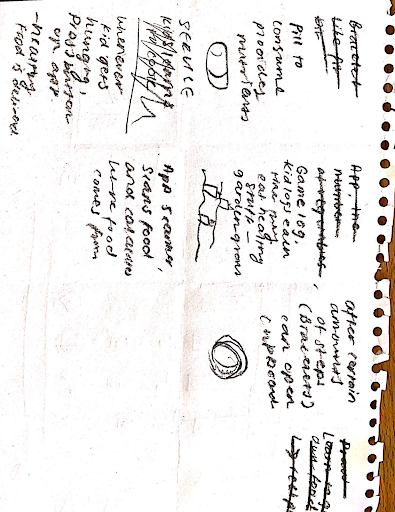
Healthy Hop

Healthy Hop
Team: Justin heish || sally sui || Tara song || macy chong
Timeline: 12 weeks, 2019
Role: User researcher, leader of user testing, storyboarding
Tools: photoshop, premier pro, design techniques and methodologies
Our design solution is a direct response towards the issue of child obesity as our product “Healthy Hop” was created with the intention to incentivise Primary School children to partake in more physical activities and Healthy snacking.
Problem Area
Our team decided to focus on the numbers of obesity within children and early teenagers that have prominently risen in the last decade - with the most common cause being due to unhealthy eating and a lack of exercise. From the research conduct we found that there has been a notable trend towards convenience foods and packaged foods that can be prepared quickly and easily (Symons, 2007). And obese children have a higher risk of breathing difficulties, fractures, hypertension, insulin resistance, and early markers of cardiovascular disease (WHO 2016a). Thus, presenting a suitable and impactful area of interest for our problem context.
From this, by utilising multiple research methods such as ideation, sketching, prototyping as well as user testing we were enabled to come up with our final solution. The “Healthy Hop” a vending machine that accommodates and promotes healthy lifestyles through basic exercise and rewards kids with healthy snacks in exchange for points that they have earned.
Design Solution
Students buy food at canteens, cafeterias and vending machines which has a massive influence on their food choices. Thus, existing solutions that have been implemented are school policies that regulate what foods are available to buy and physical activity programs which enable students to participate in physical activity. While these solutions have merits we aim to try and create a more innovative solution that will encompass both the aspects of healthy eating and physical activity to suit the needs of our target users.

… Thus, we propose to you
the ‘Healthy Hop’. It is a kid friendly vending machine that provides free healthy food in exchange for a certain amount of exercise. It will be implemented in primary schools with a preference for schools that don’t have a canteen. It will be linked with either a handball, soccer ball or skipping rope and so the user can scan the equipment and press start on the vending machine, they will then use it for however long they want and, in the time, that they use it they will collect points. When they reach 100 points the equipment will make a sound and tell them that they’d reached 100 points. They can then scan the equipment again to see how much points they have and then depending on how many points they have they can pick an item of food that they want to get. These functions and features will be further explained later on.

Research Methods
Interviews
We created three different forms of interview questions targeting Teachers, Parents and Primary School Children. With each category receiving interviews that focused on their relationship with the user. For example with Parent Interviews, we strived to understand the parents perspective of children's health.
As a result, We conducted eight 15 minute interviews:
Four with Children varying between the ages of (5 -12)
Two with Parents of Primary School Children
Two with Primary School Teachers
Insights
Parent Insights
From the interviews we found that parents are somewhat concerned with their children's health, especially when they display signs of laziness and constant eating, however either do not have time or just choose not to take any big actions in preventing these issues from growing. Parents assume that although their child many show signs of unhealthy lifestyle, they assume that due to their young age, it is not a concern as they will eventually grow out of it. Parents believe there is no harm in providing children with unhealthy foods during recess and lunch as they are still growing.
Teacher Insights
According to teachers, the number of students partaking in physical activities is noticeably getting lower each year. Teachers state that they have noticed many more students gravitating towards technological devices at lunchtimes as opposed to physical activity, so much so that mobile phone bans are in talks. Teachers have also observed that many students spend their lunchtimes discussing video games, social media influencers, and the latest technological trends.
Student Insights
The students who do not partake in physical activities during lunchtimes spend it talking, and discussing about social media influences, trends or gaming. - Usually done while sitting down in one area for the entire lunchtime or aimlessly wandering around. The most popular sports that are played are Soccer, Handball and Skipping - Some students play everyday, while others once a week. Students are usually incentivised to partake in physical activities by their friends and peers.
Students usually buy unhealthy food at canteens, with the most frequent foods being ice blocks and chips. Canteens are used regularly with some students using a canteen almost daily, and some weekly. Students, unless heavily told by parents or other students, do not care about maintaining a healthy lifestyle at their age. - Usually due to a lack of awareness, understanding or need to monitor their lifestyle
Design Criteria
From these insights we formed three opportunity statements to help us when designing or solutions these were
In order for a company to succeed, they must intrinsically understand the human need for a greater lifestyle
We need to create a product that positively reflects on the morals and ethics of consumers - specifically the growing concern of obesity with children
The food industry should aim to enhance and supplement the current ideals of consumers
Tackles current obesity issues with children, while creating a new lifestyle norm for them to adapt for future
Our product aims to tackle the wicked problem of personal sustainability within an individuals lifestyle. Specifically in the area of the growing concern of child obesity. An issue that is assumed to be correlated with laziness an unhealthy eating. Therefore, Our product strives to tackle these issues specifically, ensuring that users are encouraged to exercise and eat healthier snacks.
The industry has the opportunity and responsibility to shape the future of society, allowing for this market to expand, granting a larger mass of sales
Make the idea of Healthy Lifestyle appealing to Children
Our broader aim is that by shaping a healthy lifestyle for primary school children, we are indirectly guiding consumers at a younger age to be healthier, shaping the overall issue of obesity
Ideation
When thinking of ideas we decided to use several techniques such as the ‘mash up’ technique, the crazy 8’s as a form of brainstorming
From using the ‘mash up’ and crazy 8’s technique the Hula Hoop Cooking Recipe Game and the Cupboard lock were our best ideas


By building on our ideas, and combining key features together, it lead to us to creating the rough concept of our final idea - The Vending Machine in the house that contains healthy foods which can only be unlocked through points earnt by exercising and sport. Through four separate interviews with different primary school kids, we were able to narrow down the most popular sport played during lunch periods. That being - Soccer, Handball and Skipping. Therefore, we decided to use those 3 sporting equipment for our vending machine product
To flesh out this concept we decided to use the co-sketching technique which involved sketching out designs and constructively critiquing them.
From these sketches and critiques the result was:
Deciding on using a horizontal size Vending Machine, in order to be more accessible to shorter children.
Choosing to create a digital food selection, as opposed to using a keypad, in order to ensure easy access for children.
Deciding on a rough sketch of what the final Vending Machine may look like
And upon further reflection, we came to the conclusion that there was not enough incentive for a vending machine to be placed in a home environment, as children could just get food out of the cupboard. Therefore, we decided to repurpose our product in a Primary School Environment.
Low-Fidelity Prototyping
We then decided to create a low-fidelity prototype of the vending machine screen and the functions of the vending machine itself so that we would be able to user test it later.
User Testing

We conducted user testing with our food selection screen mock-ups on 4 participants, their age ranging from 5-12. We wanted to find out whether our vending machine screen was easy and efficient to use however user testing with children proved to be a very big challenge. Most of the children didn’t have any problems with the screen and found it very easy to use because it was touch screen and had pictures of the items of food that they wanted to get. They did want to on click more than one item, however they didn’t have enough coins to do that and some of them would get bored and gave up before even reaching enough points. Thus, we have made the point system, so that when you bounce the ball you get one point.
PARENTS
Regarding our design solution there was an overall positive reaction.
Parents believed that this was a very effective and child friendly means to promote a healthy lifestyle and also enjoyed that the product is able to teach young children healthy habits at a young age
TEACHERS
There are potential concerns that the point system of the product may promote children to be overly competitive which may distract them from classes.
Concern that healthy foods are not strong enough incentives to attract children
However overall positive reaction to the product
STUDENTS
Free food and playing with their friends is the biggest incentive for students
Children had a strong positive reaction to the product
Final Solution

So What is the ‘Healthy Hop?’

Our Product takes the conventions of physical activity and the use of Vending Machines and gamifies these elements. The use of monetary currency to access food within the vending machine is removed completely and substituted with a point system earned through commitments towards physical activities. Simply put, the product involves the user building up points by using our sporting equipment, and with these earned points they can use it to earn foods from our Vending Machines.
There are Three Key elements at play:
The Sporting Equipment
The Point System
The Vending Machine
During Recess or Lunchtimes, users can use our gamified sporting equipment which includes, a soccer ball, handball and skipping rope. With every action performed with these equipment, points begin to build up overtime and once the student is ready, they can simply go to one of our Vending Machines that have been positioned inside the Primary School and scan the sporting equipment onto the Vending Machine (which can be seen in the storyboard). The result of this transfers the points earned into the machine, allowing the user to choose from a variety of twelve different healthy snacks. The more enticing the snack is the more points it is worth.

The Sporting Equipment
We intentionally designed the sporting equipment scanner to resemble a barcode as from a stylistic standpoint, the use of a barcode deeply resembles the scanning system at a supermarket self checkout system. By doing this, we are utilising a technique users may already be familiar with, and as a result, reduces error rates and confusion and maximises efficiency and clarity.
The effects of this was made extremely evident through our user testing, as users immediately were able to decipher that the barcode was the area where they had to scan at the vending machine.
Despite the appearance of the scanner being a barcode, this is merely a stylistic choice to ensure familiarity and intuitiveness. Unfortunately the nature of barcodes can merely store information and not manipulate it. Therefore a normal barcode would not work for our product as the information (points) change the more the product is used.
To combat this, there is actually a digital scanner hidden behind the shell of the sporting equipment, directly behind where the barcode is positioned. This digital scanner allows the sporting equipment to add points as the product is used and transfer them to the vending machine when done. We disguised this digital scanner with a more user friendly barcode in front to ensure greater intuitiveness for users.
The Point System
We needed to ensure points could be easily collected and built up, yet at the same time not abused.
Therefore points are earned on a “One action, One point”.
This means a single point is earned simply by performing a action that is associated with the chosen sporting equipment. For example one point is earned for every kick of a soccer ball, hit of a handball or skip of the skipping rope.
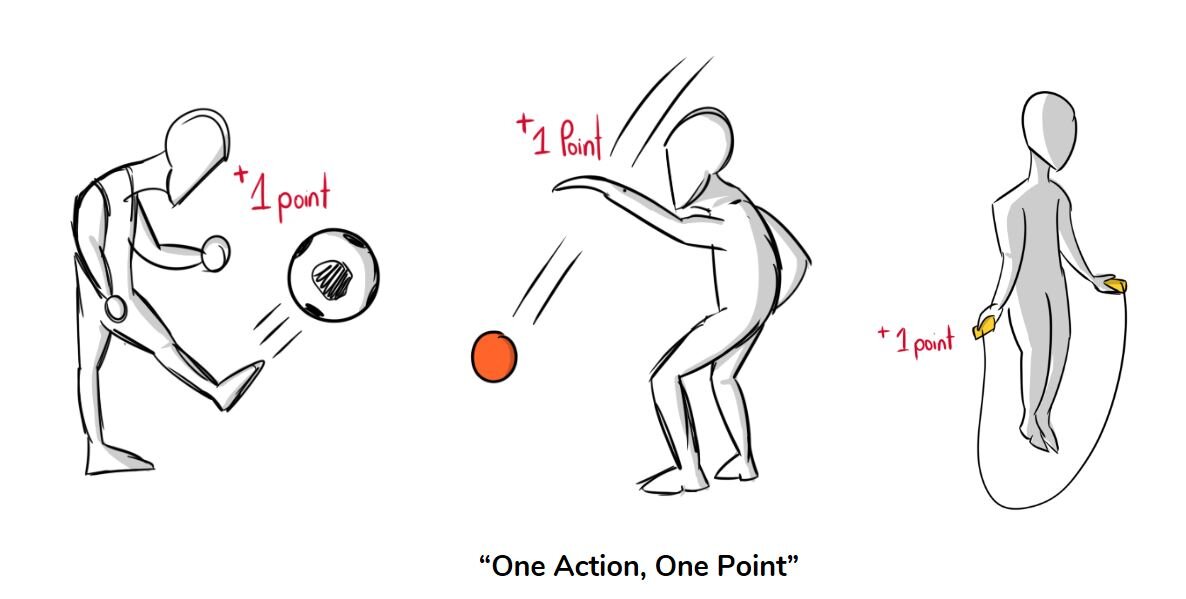
Milestones and Reset Functionality
To allow Users to be able to keep track of significant point benchmarks, for every 100 points earned, the used sporting equipment would create noise feedback with the words “You’ve got one hundred points!” This feedback creates a sense of indication towards users achievements, while also further incentivising the user to keep going.
To ensure maximum simplicity, there will be no manual reset feature to reset the points, instead, points will reset every consecutive hour the moment the equipment becomes inactive and not in use. This means users do not overly abuse point system over long periods of times.
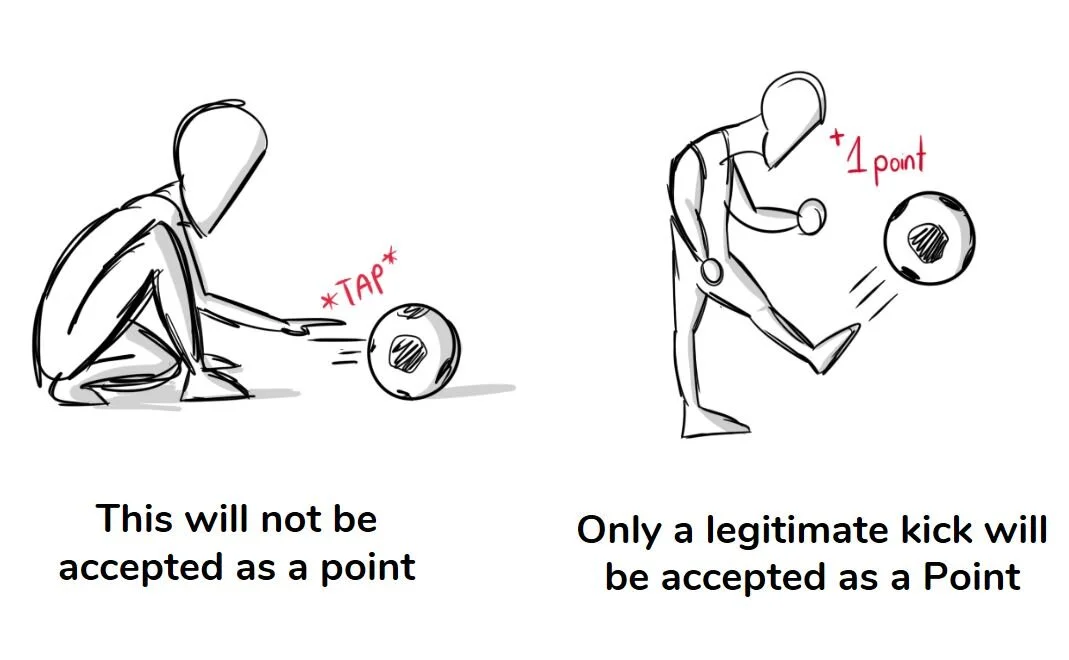
Prevention of abuse of the Point System
We have incorporated a vibration sensor inside the equipment which senses the impact made towards the sporting equipment for example the kick of a soccer ball, and through this the vibration sensor sends a signal towards the point tracker and adds one point.
It is also there to prevent users from abusing the point system. An early issue that we thought of was that users could simply lightly tap a soccer ball, rapidly bounce a handball close to the ground or just rotate the handles of the skipping rope to build up points. To prevent this issue, the vibration sensor ensures that only legitimate use of the sporting equipment would equal a point. This means a point can only be counted if the ball senses the actual power of an average primary school student kick. Preventing any forms of point abusing and ensuring the users are actually partaking in these physical activities.
The Vending Machine
The Vending Machine element of Healthy Hop serves as the physical foundation of the entire product.
Unlike the tall vertical shape of regular Vending Machines, our design strived to be very kid friendly by using the colour blue and being 155cm tall to ensure it is at a reachable height for primary school students.
Additionally, there are clear visible instructions one the top right of the machine, to ensure that if a user is ever lost, they can easily realise what they need to do.
Unlike some Vending machines of today, the snack selection screen is not a numbered keypad, but instead of a digital screen that ensures visibility and improves on the overall accessibility of the product, as it is a far more user friendly option as opposed the numbered keypad.
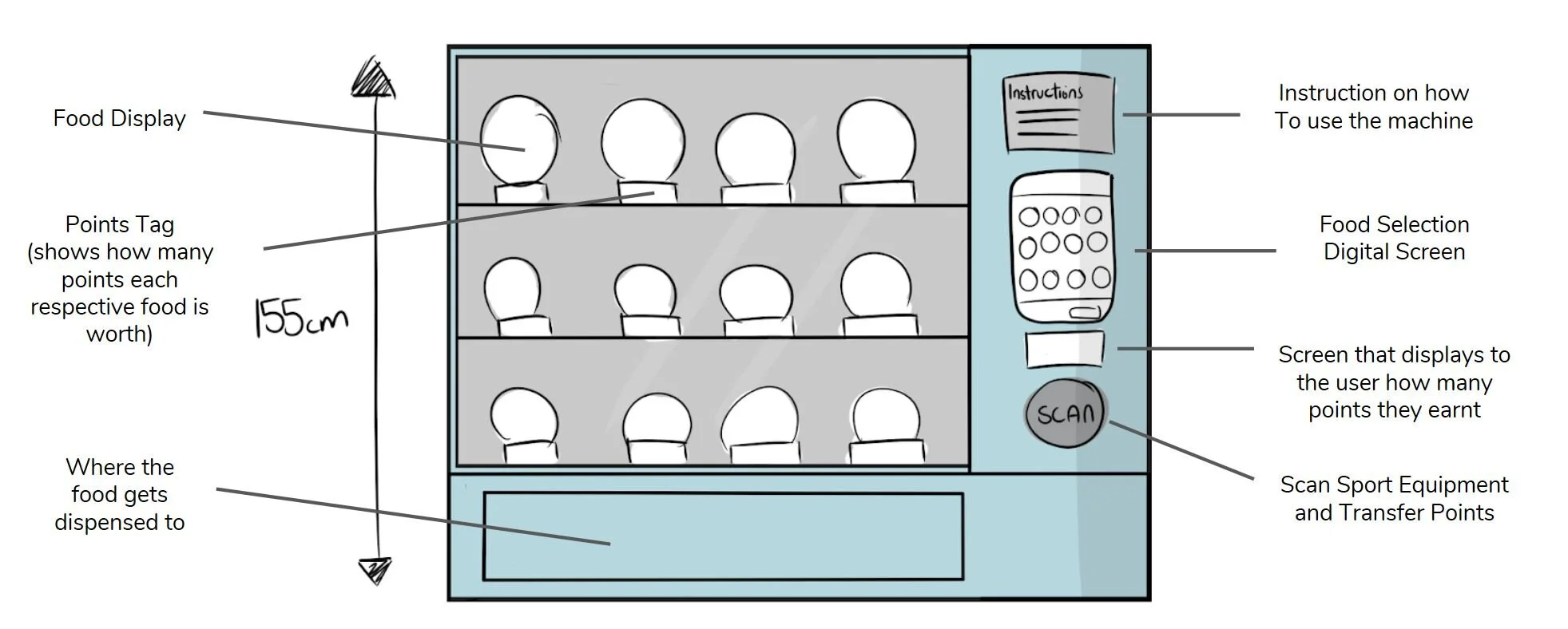
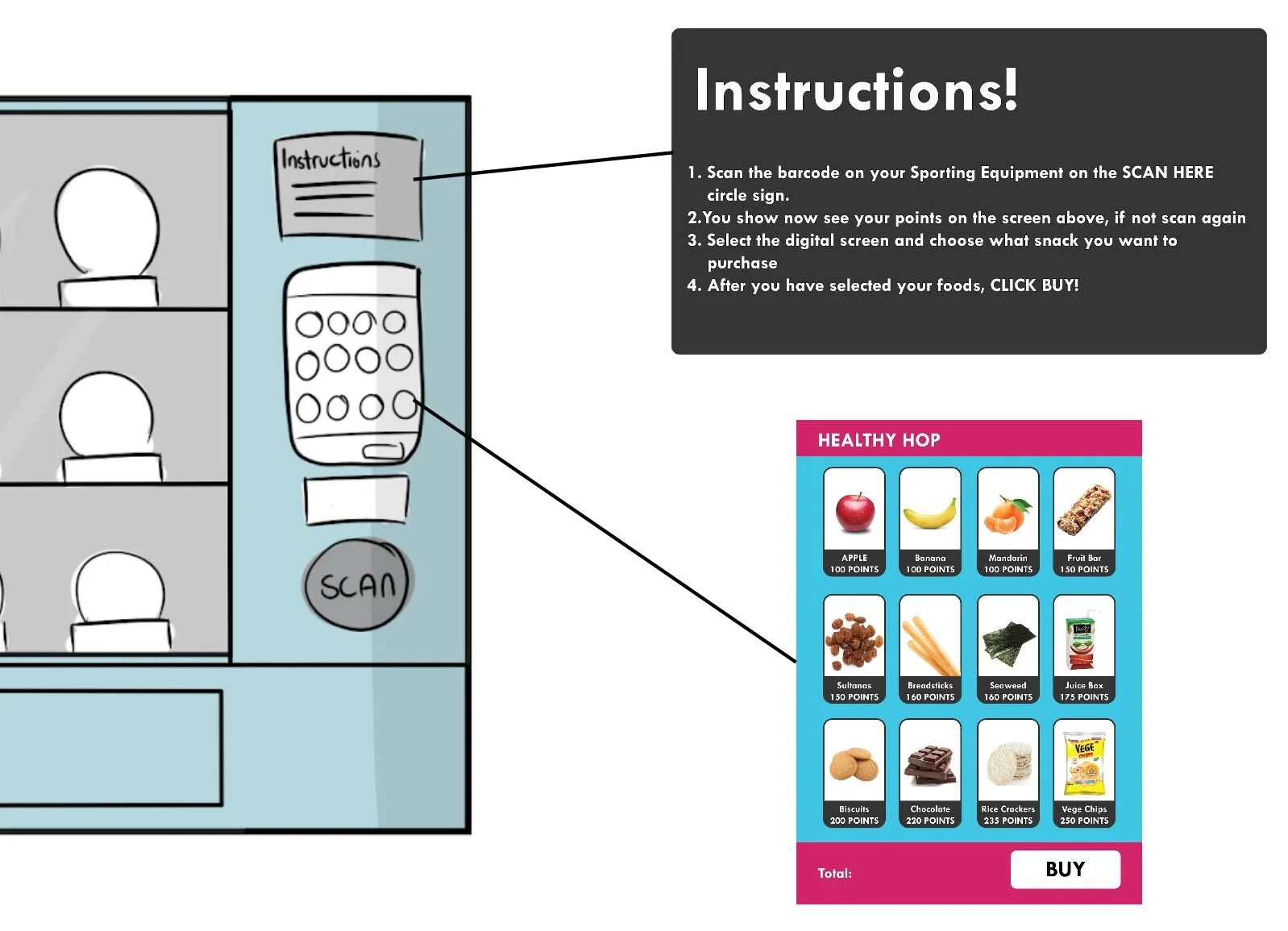
So how does this improve healthy living?
The importance of healthy lifestyle, although the issue is very much still a concern, due to the mundane nature of the topic, is simply not appealing towards children.
However, by gamifying the idea of healthy lifestyle to children, it may potentially be more appealing. Our product is not about forcing dieting or lecturing children on what is right or wrong about the way they live their lives. It’s about REWARDING children and letting them WORK TOWARDS POINTS. Yes, the product is founded on combating child obesity, however we did not want the users to feel like a new lifestyle is being enforced onto them.
We wanted the product to feel fun, modern and appealing. The gamified Vending Machine allows students to actually partake in physical activity without it feeling like a chore or an effort, and it is through this, that we believe our product is differentiated from the rest of the food industry.
Our product does not feel like an added addition to the ever expanding list of healthy snacks, instead it creates a new incentive for children to have fun with the added benefit of personal sustainability.
Ways forward
Potentially in the future, there is a hope to expand our selection of sporting equipment. As of right now, we prioritised the three most popular sporting equipment within the primary school environment. That being soccer, handball and skipping however, in future, to ensure a larger universal appeal to all primary school students to enjoy, including equipment such as basketball or touch football.
Furthermore, there are small “what if” scenarios that could potentially disrupt the flow of the user journey. This includes: What if a user wanted to check their points as they were using the sporting equipment? As of right now, the only means for users to know their specific points is if they run back to the vending machine and check their points
We aim to look further into creating a more seamless and intuitive approach towards calculating and viewing point totals.
